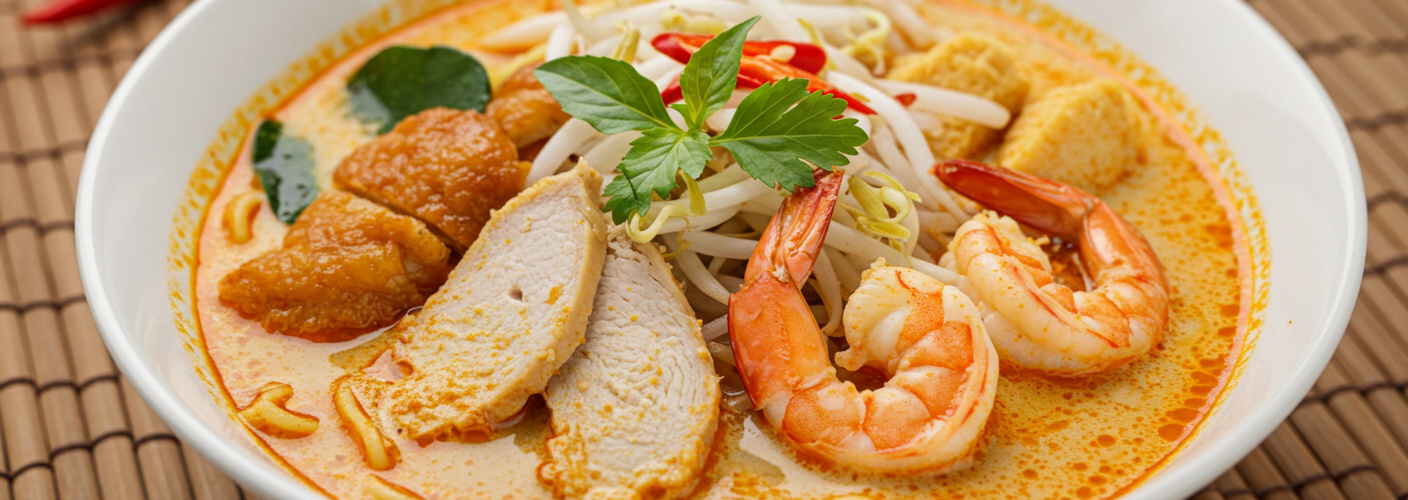Laksa, a traditional dish beloved across Southeast Asia, is a vibrant and spicy noodle soup that tantalizes the taste buds with its rich blend of flavors and textures. Known for its aromatic coconut milk base, laksa can be enjoyed with various protein options, including chicken, prawns, or fish, making it a versatile meal that appeals to many.
Originating from the Peranakan culture, which merges Chinese and Malay influences, laksa has evolved into a favorite across multiple countries, including Malaysia, Singapore, and Indonesia. Each region boasts its own unique take on this iconic dish, with variations that reflect local ingredients and culinary traditions.
At the heart of any good laksa is the spice paste, which usually includes a mix of ingredients like lemongrass, galangal, turmeric, and garlic. This paste is often pounded or blended into a smooth consistency to create a flavorful base that imparts the soup’s signature kick. Depending on the region, laksa can be categorized into different kinds, the most famous being Curry Laksa and Asam Laksa.
Curry Laksa, commonly found in Singapore, features a creamy coconut milk broth infused with spices and herbs, providing a sumptuous and slightly sweet flavor profile. The noodles are typically thick rice vermicelli, which soak up the soup’s rich flavors. It’s commonly topped with chicken, prawns, or tofu, and garnished with fresh bean sprouts, boiled eggs, and coriander, enhancing both the presentation and taste.
On the other hand, Asam Laksa is a tangy variant primarily popular in Penang, Malaysia. It offers a stark contrast to its curry counterpart, with a fish-based broth that is both sour and spicy, thanks to the addition of tamarind. The noodles used here are often a thinner rice noodle known as “laksa,” and the dish is traditionally topped with mackerel, cucumber slices, mint, and pineapple, presenting a refreshing yet spicy culinary experience.
What makes laksa appealing is not just its engaging flavors but also the comforting nature of a warm bowl of noodle soup. The combination of the spicy, creamy broth with the chewiness of the noodles creates a generous texture that satiates and delights. Laksa is not merely a dish; it’s an experience that engages all the senses. The vibrant colors of the fresh ingredients and aromatic herbs create an enticing visual, while the complex blend of spices delivers a delightful aromatic contrast.
As one explores laksa, it becomes apparent that it holds cultural significance, often associated with family gatherings, festivals, and celebrations. Whether enjoyed in a bustling hawker center or prepared lovingly at home, each bowl of laksa tells a story of heritage, regional pride, and culinary artistry.
In summary, laksa is not just a meal—it’s a cultural icon that encapsulates the essence of Southeast Asian gastronomy. With its spicy, aromatic, and hearty nature, this noodle soup has earned its place on the tables of many, inviting food lovers to indulge in its delicious embrace. Whether you prefer the creamy notes of curry laksa or the sour punch of asam laksa, each version offers a unique reflection of the rich culinary traditions of the region, making it a must-try for any food enthusiast.




Add comment